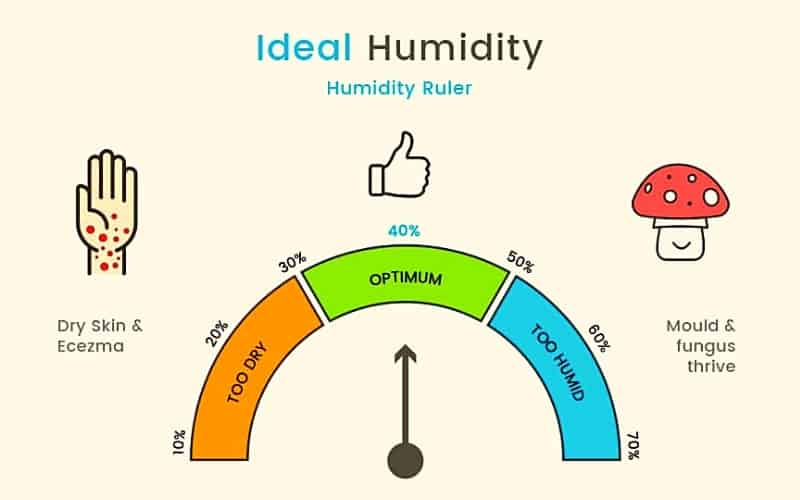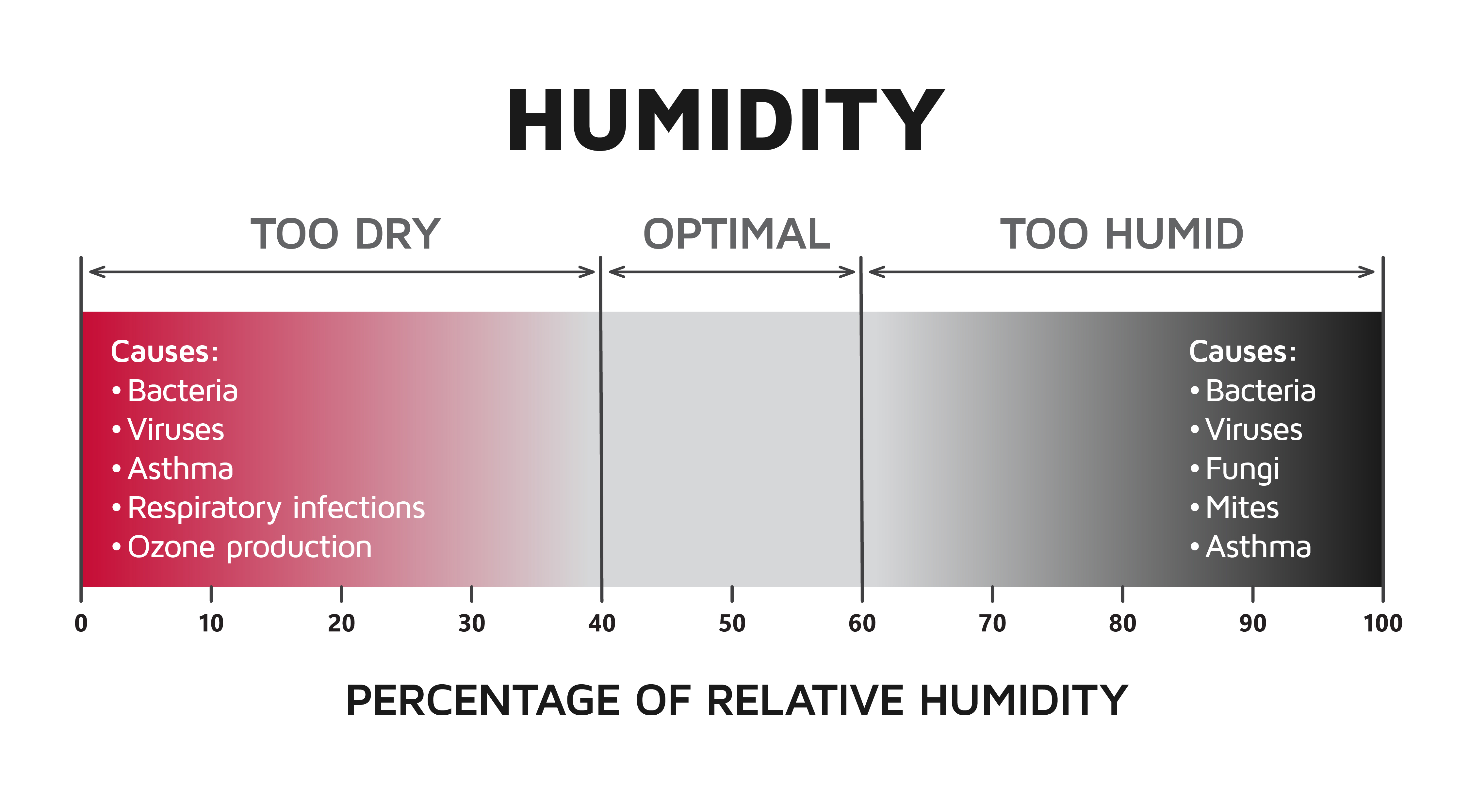What Is A High Humidity Level

High humidity can feel like a heavy, wet blanket draped over your home or business, impacting comfort, energy bills, and even the health of your building. Understanding what constitutes high humidity, its causes, and, most importantly, how to combat it, is crucial for anyone looking to save money and create a healthier, more efficient environment. Whether you're a homeowner wrestling with summer stickiness, a business owner looking to reduce operating costs, or an HVAC professional seeking to educate your clients, this comprehensive guide will provide the knowledge you need.
Defining High Humidity: A Matter of Relative Perspective
Humidity, at its core, refers to the amount of moisture in the air. However, it's not just about the raw quantity of water vapor; relative humidity is the key metric. Relative humidity (RH) is expressed as a percentage and represents the ratio of the amount of water vapor present in the air compared to the maximum amount the air could hold at a specific temperature. Warmer air can hold significantly more moisture than cooler air, which is why a seemingly moderate RH in summer can feel oppressive, while the same RH in winter might feel dry.
So, what's considered "high"? Generally, an indoor relative humidity level above 60% is considered high. The Environmental Protection Agency (EPA) recommends maintaining indoor RH levels between 30-50% for optimal health and comfort. When RH consistently exceeds 60%, it creates conditions ripe for mold growth, dust mite proliferation, and other issues that can negatively impact indoor air quality and increase energy consumption.
The Hidden Costs of High Humidity: Beyond Discomfort
The immediate impact of high humidity is often discomfort – that sticky, clammy feeling that makes you want to crank up the air conditioning. But the consequences go far beyond mere inconvenience:
- Increased Energy Bills: High humidity makes your air conditioner work harder to cool your space. The AC not only has to lower the temperature but also remove excess moisture from the air. This increased workload translates directly into higher energy bills. According to the U.S. Department of Energy (DOE), for every degree you lower your thermostat, you can save up to 3% on your energy bill. However, in humid conditions, you might be tempted to set the thermostat even lower, negating those potential savings.
- Mold and Mildew Growth: Excessive moisture provides the perfect breeding ground for mold and mildew. These fungi can damage building materials, trigger allergies and respiratory problems, and create unpleasant odors. Mold remediation can be costly and disruptive.
- Dust Mite Infestation: Dust mites thrive in humid environments. These microscopic creatures are a major allergen source, contributing to asthma, eczema, and other allergic reactions.
- Structural Damage: Over time, high humidity can lead to wood rot, corrosion, and other forms of structural damage. This can weaken the integrity of your building and necessitate expensive repairs.
- Health Problems: Beyond allergies and respiratory issues, high humidity can exacerbate other health conditions such as arthritis and cardiovascular problems.
What Causes High Humidity Indoors?
Several factors can contribute to high humidity levels inside your home or business:
- Outdoor Humidity: In many regions, particularly during summer months, the outdoor air is naturally humid. Infiltration of this humid air through cracks, leaks, and poorly sealed windows and doors can significantly raise indoor humidity levels.
- Poor Ventilation: Insufficient ventilation traps moisture inside. Activities like showering, cooking, and even breathing release moisture into the air. Without adequate ventilation, this moisture accumulates, leading to higher humidity.
- Leaky Plumbing: Even small leaks in pipes, faucets, or toilets can contribute to elevated humidity levels over time.
- Damp Basements or Crawl Spaces: These areas are often prone to moisture problems due to groundwater seepage or poor drainage.
- Household Activities: Activities like drying clothes indoors, boiling water without a range hood, and even having numerous houseplants can increase indoor humidity.
Solutions for Combating High Humidity: A Multi-Pronged Approach
Addressing high humidity requires a combination of strategies:
1. Improve Ventilation:
Proper ventilation is crucial for removing excess moisture from the air. Consider these options:
- Exhaust Fans: Use exhaust fans in bathrooms and kitchens to vent moisture-laden air to the outside. Ensure the fans are properly sized for the room and are vented correctly.
- Open Windows and Doors: When outdoor humidity is lower than indoor humidity, opening windows and doors can help ventilate your space. However, be mindful of pollen and other allergens.
- Whole-House Ventilation Systems: For more comprehensive ventilation, consider installing a whole-house ventilation system such as an Energy Recovery Ventilator (ERV) or a Heat Recovery Ventilator (HRV). These systems exchange stale indoor air with fresh outdoor air while minimizing energy loss. Many ERVs and HRVs are Energy Star certified.
2. Control Moisture Sources:
Identify and eliminate sources of excess moisture:
- Repair Leaks: Promptly repair any leaks in plumbing fixtures, roofs, or foundations.
- Seal Cracks and Gaps: Seal cracks and gaps around windows, doors, and pipes to prevent humid outdoor air from infiltrating your space.
- Use a Dehumidifier: Dehumidifiers remove moisture from the air, helping to lower humidity levels. Choose a dehumidifier that is appropriately sized for your space. Look for Energy Star certified models for optimal energy efficiency.
- Properly Vent Appliances: Ensure that clothes dryers and other appliances are properly vented to the outside.
3. Optimize Your HVAC System:
Your HVAC system plays a critical role in controlling humidity. Consider these strategies:
- Regular Maintenance: Regular maintenance, including cleaning or replacing air filters, ensures that your AC system is operating efficiently. Dirty filters restrict airflow, reducing the system's ability to dehumidify the air.
- Proper AC Sizing: An oversized AC unit can cool your space too quickly without effectively removing moisture. Conversely, an undersized unit will struggle to maintain comfortable temperatures and humidity levels. Consult with an HVAC professional to ensure your AC system is properly sized for your needs.
- Variable-Speed Air Conditioners: Variable-speed AC systems offer superior humidity control compared to traditional single-speed units. They can run at lower speeds for longer periods, effectively removing moisture without overcooling the space.
- Smart Thermostats: Smart thermostats can monitor humidity levels and automatically adjust your HVAC system to maintain optimal comfort and energy efficiency. Many models also offer features like remote control, energy usage tracking, and integration with other smart home devices. Some smart thermostats can even trigger alerts when humidity levels exceed a certain threshold.
4. Smart Home Integration for Enhanced Humidity Control
Smart home technology offers powerful tools for monitoring and managing humidity levels. Integrating smart thermostats, humidity sensors, and other devices can provide greater control and automation.
- Smart Humidity Sensors: Place smart humidity sensors in various locations throughout your home to monitor humidity levels in real-time. These sensors can send alerts to your smartphone or other devices when humidity levels exceed a set threshold.
- Automated Dehumidifier Control: Connect your dehumidifier to a smart plug and integrate it with your smart home system. This allows you to remotely control the dehumidifier and automate its operation based on humidity levels.
- Voice Control: Use voice commands to adjust your thermostat, turn on your dehumidifier, or check the current humidity level.
ROI, Energy Savings, and Rebates
Investing in humidity control measures can yield significant returns:
- Reduced Energy Bills: Lowering humidity levels can reduce the workload on your AC system, resulting in lower energy bills. The exact savings will vary depending on your climate, the size of your space, and the efficiency of your HVAC system.
- Improved Health: Controlling humidity can reduce mold growth, dust mite infestations, and other allergens, leading to improved indoor air quality and fewer health problems.
- Prevented Structural Damage: By preventing moisture damage, you can avoid costly repairs to your home or business.
Many utility companies and government agencies offer rebates and incentives for energy-efficient HVAC equipment, dehumidifiers, and smart home devices. Check with your local utility company and the Energy Star website for available rebates and programs. The Inflation Reduction Act has also expanded access to rebates for energy-efficient home upgrades, so be sure to investigate federal incentives as well.
Conclusion: Taking Control of Your Indoor Environment
High humidity is more than just an inconvenience; it's a drain on your energy budget, a threat to your health, and a potential source of structural damage. By understanding the causes of high humidity and implementing the strategies outlined in this guide, you can create a healthier, more comfortable, and more energy-efficient environment for yourself, your family, or your business. From simple solutions like improving ventilation to advanced technologies like smart thermostats and whole-house ventilation systems, there are numerous options available to help you take control of your indoor environment and reap the benefits of a balanced and comfortable living or working space. Consult with a qualified HVAC professional to determine the best solutions for your specific needs and to ensure proper installation and maintenance.

.jpg?width=3508&name=Humidity level chart (1).jpg)







